 |
real Middle-Earth is true 
All the oldest and greatest dynasties of the Great Steppe trace their origin from the Scythians. Like the Latins in the Mediterranean, the Scythians and Saks, related to them, were the rulers of the Middle-Earth of Europe and Asia. But like the Latins they did not disappear, the Scythians reformatted into Huns and Turks. 
Turan - the Scythian steppes, are a Middle-Earth in real, but not a fairy tale and is not fantasy
According to historians, the Scythian speech was similar to Parthian (Persian). But this is not exactly known. The Scythians left no books or writings. Nowadays the descendants of the Scythians speak Turkic languages. The main centers of development of Scythian civilizations were: the Black Sea region and the Don River - in the west; in the east, it is a vast valley of the upper reaches of the Yenisei River, between the Altai and Sayan mountains, in the very center of Asia. Archaeologically both halos of the Scythian habitat have much in common.
In Central Asia (Altai) the Scythians left the Pazyryk, Tagar, Tashtyk, etc. This archaeological cultures that formed the core of the ancient Xiongnu (Hunnu, Huns). 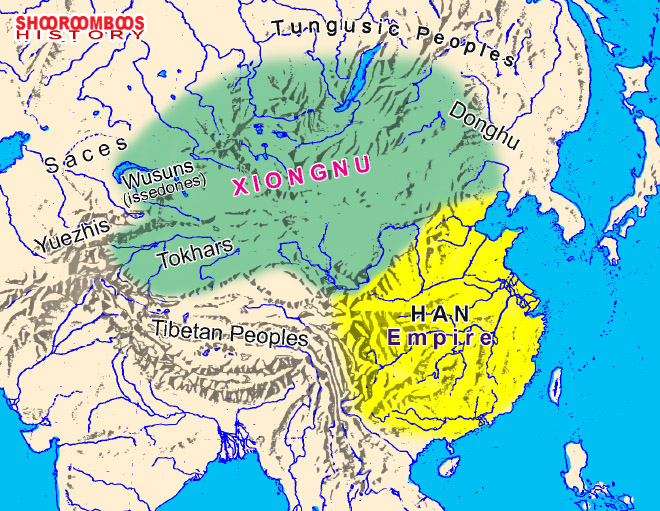
The Empire of the Xiongnu (Hunnu, Huns) near ancient China - the Han
Evidence of the Xiongnu was left mainly by the Chinese, for example, the author is Sima Qian.
The rulers of the Xiongnu were called the Chinese - Shanyu. What the Xiongnu themselves called them can only be assumed. Perhaps something like: Khanar, Hunar, or Hangur. If we take into account that the descendants of the Xiongnu (Hunnu) - Huns were called Hungur, Onogur, then the name of the title like Khungur or Hangur is preferable. 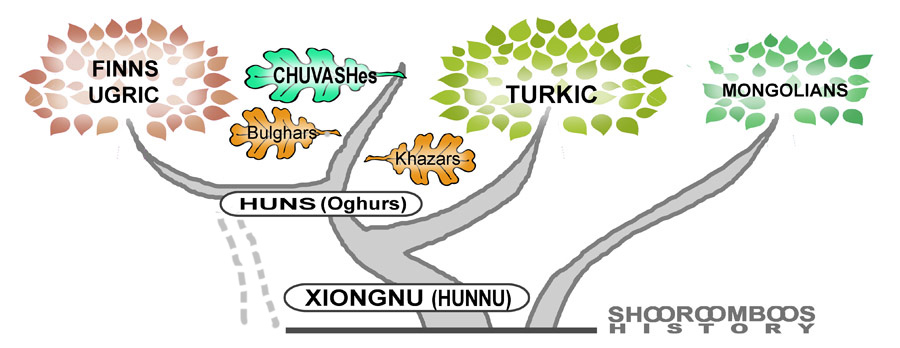
The tree of the Altaic languages (according by historian Shooroomboos). The influence of Hunnic (ancient Chuvash) affected many dialects of the Finns-Uralic (Finns and Ugric) family
The Chinese called Shanyu clan of Xiongnu - Hou-Yang (Yong). This exonym in Chuvash can be interpreted from the syllables: Hu and En, Hu - is the name of the genus, and a En (Yeng) - in Chuvash it means side or country; that is, Hu En (Hou Yeng) - is the country of Hu. From the root "hu" came the name of the people - the Huns (Hunnu), the Hunni (Huns) - belonging to the Hu.
In the west, on the Don river and at the Euxine Pontus (Black Sea), another Great Scythian dynasty appeared. It developed among the lords of the Bosporan kingdom on the basis of the Scythians or Sarmatians.
The famous Pontic king Mithridates VI Eupator (late 2nd century BC) descended from the Persian Achaemenid kings (Asemeni), who were Darius, Cyrus, Xerxes and others. On the other hand, on Laodice's mother's side, from Alexander the Great (Macedonian) himself was considered his ancestor.
In addition to the Minor Asian possessions, the power of Eupator of Pontus extended to the Bosporan kingdom, which became his last refuge.
The local name of the city of Tanais, apparently, was Chuvash - Asgard, from the Chuvash words "qarda" (kart) - a fence; and else "qar" - protection, fortress; that is, it meant the city, fortress of the Ases. In addition, in ancient times the names Azak and As-kala were found, for example, among language of Adyg people. Among the Sarmatians there were many Amazons, in Chuvash - amazyn (амаçын) - a woman. The Aces also had direct contacts with the free steppe ladies. The mother of queen Dynamia, the granddaughter of Mithridates Eupator, was a Sarmatian Amazon. Queen Dynamia is the mother of King As Purgus. The last wife of King Eupator was also the Amazon a Hypsicrates.
By the first centuries of the new era, the Xiongnu had used up their influence in wars with the Celestial Empires (ancient Chinese kingdoms). The former Scythians became superfluous in the Gobi steppes. The royal core of the Xiongnu had to migrate to the west. Their headquarters was the Tyumen (Tumen) region, named for the ancient and first Shanyu.
The Western Aces (Asgardians) were also forced to accept the influence of the conquerors from the east. Moreover the Western Scythians and Sarmatians quickly assimilated with the newcomers. Except for the Alans, who are radically different from the rest of the nomads. However the Alans were also ruled by Ases. Alans was often called as the Oss. The Aces managed to spread among many nomadic tribes and not only them. At the beginning of the 5th century, Kan (king) Ărukil (Rugila) from the Hu (Wukil) clan allocated a new branch - the Dulo, by Chuvash - the Tulă. The basis of the new Dulo dynasty was given by the Emperor of all barbarians Attila. His probable Chuvash name sounded like - Atl (Atăl). This is how the Chuvash called the Great River (Volga), which had previously been named Rha, or Yrăh Ырăх (Arax). In the preserved namebook of the ancient Bulgarian kings, Attila is named Avitochol, distorted by Slavic scribes. True by Chuvash - Avalchi Atl - an Ancient Attila. The very nickname "Attila" was the title of a king is - Like as father, from the Chuvash "atte" - a father. Qagan Attila the Dulo was very moderate in power for his people. However, he did not forgive treason. Qagan (kaghan) is an imperial title in the Great Steppe, derived from the royal title - kan, khan. Kagan - is a kan of kans, which means king of kings. And the Haqan - Khan for Qans. 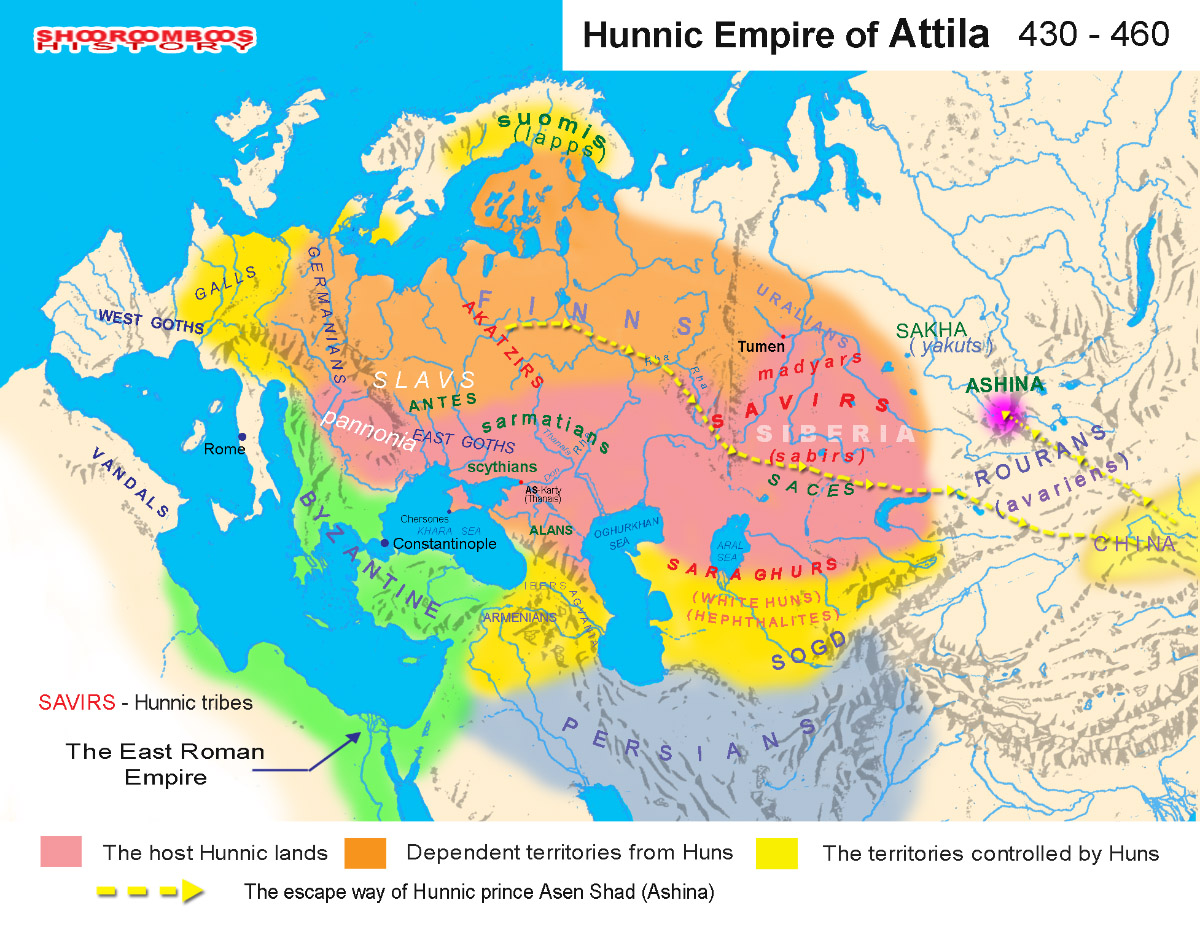
"barbarian" Empire of Attila the Hun
One of the branches of the Ases (Aces) ruled the Kasir (Aсatsir) tribe. These are the former Scythians of Aqathires, who have already become Huns. These Aces apparently sympathized with the party of Bleda is Attila's brother. The Akazirs rebelled against the king of all kings. Attila brutally suppressed the rebellion.
Attila, meanwhile, brought his vast possessions under his control. He placed his eldest son Ellak over the rebellious Akazirs. 
There is also the story of Attila and his descendants. Attila also owned another famous weapon - the Scourge of God.
Other branches of the Ases, fearing the wrath of Attila, retreated to the outskirts of the Barbarian Empire. Some other Ases moved to Scandinavia. These Ases became the kings of the Scandinavians. Wild and starved Scandinavians deified the Aesir. The Aces made a significant contribution to the fighting qualities of the Scandinavians, which emerged later. And also Ases introduced a writing system based on Chuvash runes.
Some of the Ases found refuge in the Caucasus mountains among the Alan tribes. Attila concentrated power in his own hands and his own sub-branch of the Hu (Hun) family of the Shanyu Huns - the Tulă (Dulo) clan. After Attila's death, his descendants began to divide his empire. The scattered Huns suffered a series of defeats from the rebel barbarians. Attila's eldest sons died in the fire of internecine wars. Here is the History of Attila and his Descendants >>
The youngest son Irna (Ernak, Irenik) took his Huns to the Pontic steppes (eastern Black Sea region and the Bosporan kingdom). Here this Huns were called Ogurs (Oghur), or Bulgarians. The Siberian Ases - Askils, brought their Huns is Savirs (Sabirs) to the deserted steppes between the Caucasus and the Volga (Atil). Now they have begun to dictate their terms here. However, they established partnership relations with the Dulo clan. The alliance with the Slavs and Antes also remained. The Slavs gradually settled the Roman lands along the Danube and in Dalmatia (Balkans). The queen of the Savir Huns, Boarix (Poyarik), controlled Transcaucasia, participating in the wars of the Eastern Romans (Byzantines) with the Persians. The Khazars (Kazars, Qazaqs), descendants of the Akazirs and Scythians Agathyrsians, advanced closer to the Caspian Sea. They left the lands of the Slavs under their care. The Savir Huns, friends of the Slavs and they new holders, forced them to release them. 
Steppe of the end of the 5th beginning of the 6th. centuries - territories of post-Hunnic nomads Formidable Turks
Meanwhile, far to the east, in the very center of the huge continent of As - the Asia, in the Alatu - Altai mountains, the descendants of the shad Asen mined ore and forged weapons, or rather, the people entrusted to them. The new Asen clan (Ashina) in Altai accumulated weapons and made allies among related peoples. Many subject tribes hated the evil Rouran Avars. In the east of the Great Steppe was formed new dialect of the Xiongnu, which gave rise to the Turkic languages.
By the middle of the 6th century the Asens rebelled, which was joined by most of the tribes who tired of the Avars power. The rebels called themselves Turks, or something similar. The uprising was led by the brothers Bumyn and Istemi.
In Central Asia, in the territories of ancient Turan, the Huns also dominated. Their association was called the Hephthalites. Moreover, they are known as the White Huns - Sarogurs (Shurăgur). Their possessions, extending to India and the Arabian Sea, were ruled by the Nushibi clan; where the Chuvash inflection "-bi" means a female title - Princess Nushi (or Nishu). The Turks found allies in Persia in the confrontation with the Hephthalites. Central Asia was divided between Persia and the Turks. However, the defeated White Huns stopped the advance of the Turks for some time. Meanwhile, the violent Avars went beyond the Volga to Europe. Here they found support from the Ogurs of the Dulo clan dynasty. Together with the troops of Dulo, the Avars dealt the Savir Huns, who had previously been considered invincible and formidable warriors. The Asen Turks defeated and subjugated the Hephthalites, with the participation of the Persians. The tribes of the Siberian Sabir-Ogurs, Bashgurs and Uyghurs, as well as many others, greeted the Asens and the Turks with honor. The Turks could protect these free steppes from the Avars and their allies from the west. 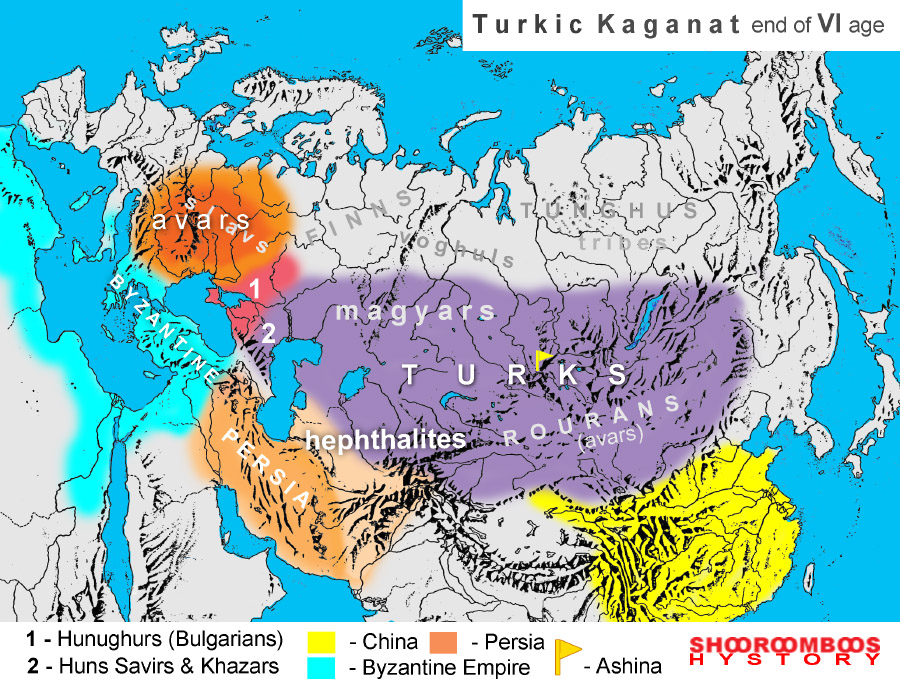
Turkic Khaganate late 6th century
The Khazars also happily awaited the descendants of their ancient rulers. After the defeat of the Savirs, only the Khazars became a noticeable force in the Caspian steppes and the Caucasus. Moreover, they are reinforced by battle-tested Turkic formations. When the Turks appeared, the Avars, who controlled the territories of the Khazars and Savirs (Suvar) near the Caucasus and the Caspian Sea, took refuge in the mountains, among the mountain tribes. Subsequently, a people formed there that took their name (Avar), but with a local language. Thus, two coalitions of the Greatest and Noble Houses of the Great Steppe were formed
In the west, the descendants of the ancient Shanyu (Hangur) from the mega-house of Hu organized themselves. By the irony of events, they found themselves in the West itself, having originally been from the East. These are the branches of the house of Hu (Wu): Dulo, Wukil (Ukil) and HuHan (HuEn).
The descendants of the Western Ases ended up mostly in the east. (If you don’t take into account the Scandinavians and Germans, who disappeared there. And who knows from whom the European royal houses come?..) Aces - they are everywhere!..
By the last quarter of the 6th century, the Ogurs, by name - Utigurs (Uturgurs), entered the Kaganlyk (empire) of the Turks. The entry was initiated on purpose, citing bad relations with another large tribe - the Kutrigurs (Kuturgurs), allied with the Avars.
Initially, the Central Asian Nushibi turned out to be allies of the Dulusians (Dulo clan). As a result, the Asen (Ashina) clan lost influence. Qaganlyq (Turkic Kaganate) split into western and eastern, along the median of Altai and Dzungarian Alatau. This is what the Dulusians needed.
The royal family of Asen lost control of the western territories of the Kaganate, but survived. Many members of the dynasty remained in Asia, most of the side branches - Ashidi. The main part of the Asen found refuge among the Khazars, the former Akazirs. The Asen became their rulers for a long time. This is how they returned to their roots - to home. The Ogur tribes of Dulo near the Black Sea and in the Don region concentrated around the Kan (king) Kubrat. Here, the former Huns, the Ogurs, have long referred to themselves as Bulgarians (Bulghar). The Dulo here allied with representatives of the related clans of the former Wu Hu, Hu En, Hu Han - Wukil (Oukil).
Two competing poles of power arose along the two seas: at the Pontus Euxine (Black Sea) - Dulo and the Bulgarians; near the Caspian Sea - the Ases, with the Khazars and their allies.
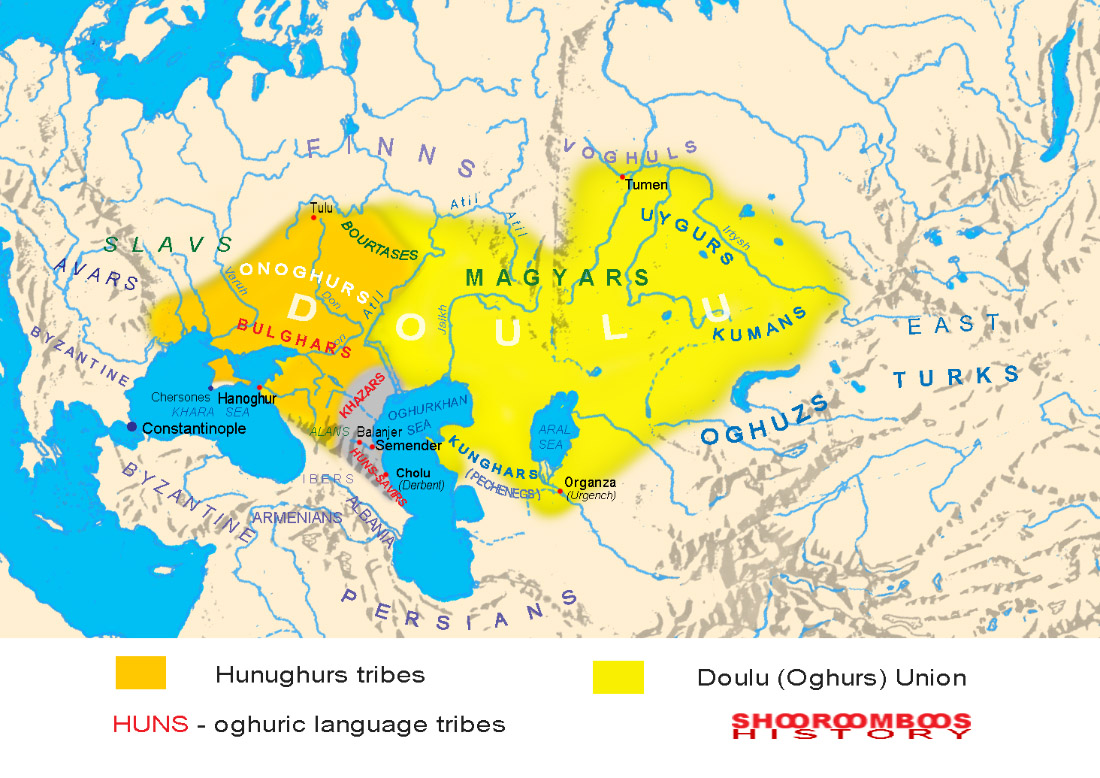
Western Turkic Khaganate - Empire of the Dulu clans 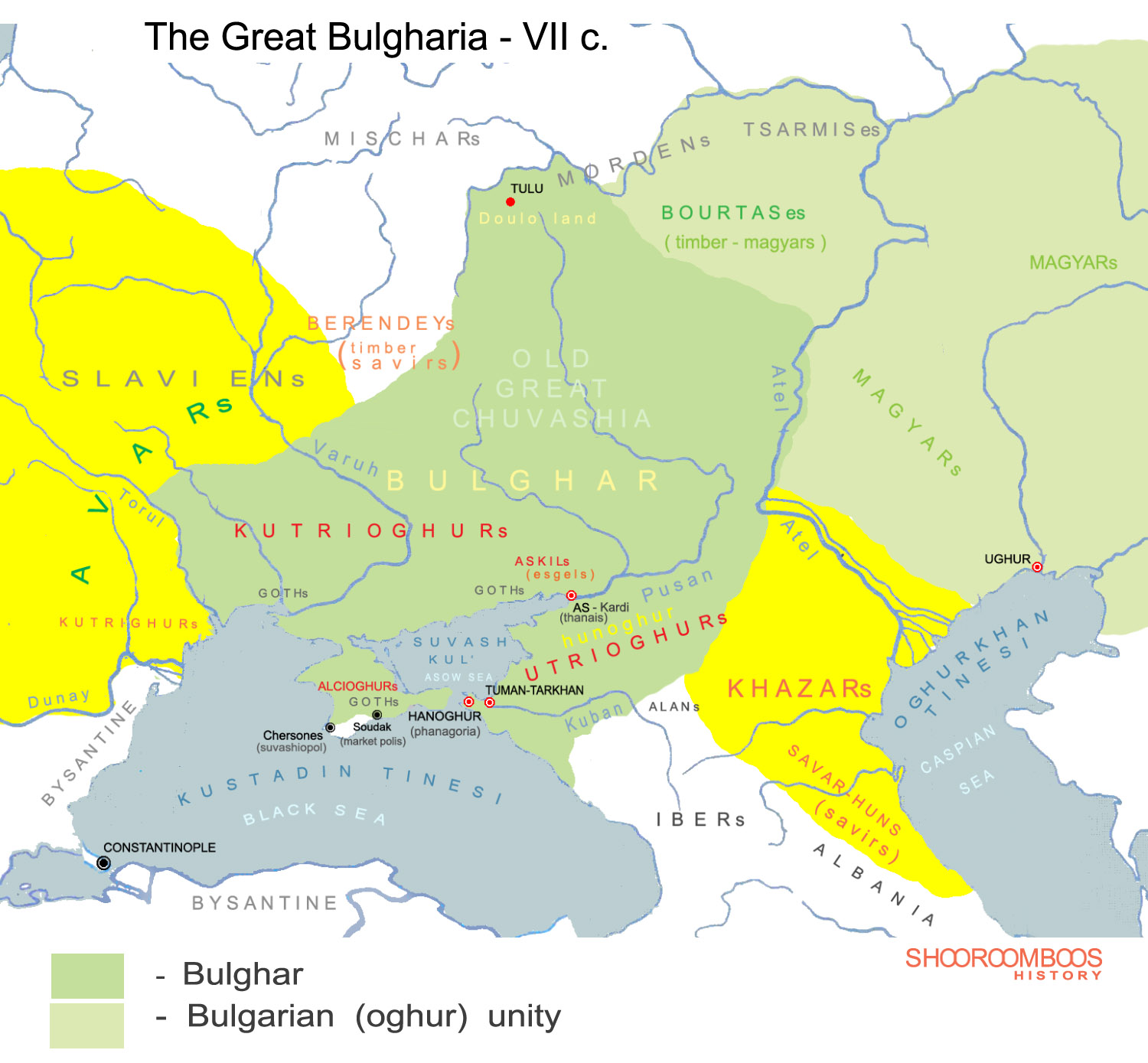
Great Bulgaria - the state of King Kubrat Dulo 
oghurs, ugrs, hungars, vunnugars The Bulgarian kan Kubrat died somewhere in the middle of the 7th century. His sons did not heed the insistence of the king-father to live in harmony. The princes dismantled the Bulgarian monolith among themselves.
Of course, the Khazars decided to take advantage of the discord among the Bulgarians. They only sharpened their swords against the Bulgarians.
The disunited sons of Kubrat were unable to resist the Khazars and their allies. The Avars, who were busy fighting the Byzantines as allies of the Persians, did not help either. The Khazars did not pursue the retreating Bulgarians, fearing that their allied Avars would enter the war. However, the Bulgarians of Kotrag still found themselves under the influence of Asen. 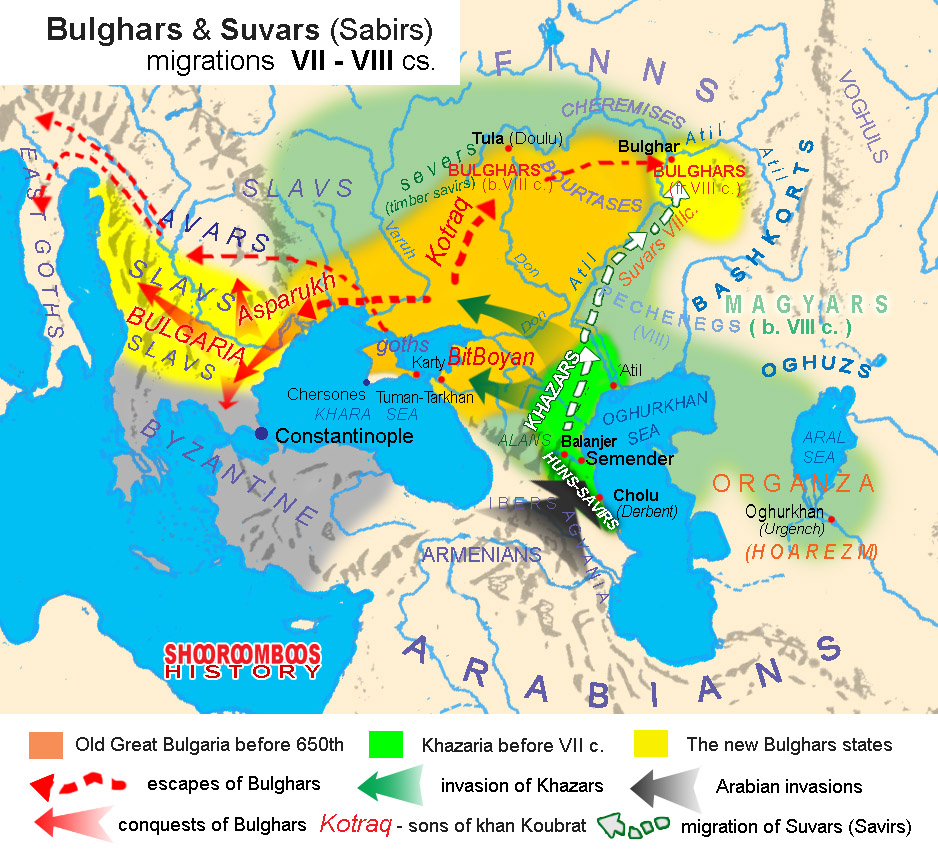
Migrations of Bulgars and Suvars in the 7th-8th centuries Asparuh was called by the Slavs who fled from the Avars to the borders of Roman Thrace ((Thracia). However, even here the Slavs found themselves in the position of slaves and serfs. The Bulgarians of Asparuh invaded the borders of Byzantium. They defeated the Roman troops and occupied the Danube territories. Since then, modern Slavic Bulgaria has appeared, which was created by the Bulgarians descendants of the Huns. Here the Slavs thanked fate that they had left the rule of the cruel Avars and Romans, to the good Bulgarians. Soon the whole of Dalmatia and adjacent territories began to be called by the name of the Bulgarians (Balkarians) - the Balkans.
Asens dealt a significant blow to their opponents a Dulo clan. Soon the Oguzes began to crowd the Ogures in the steppes of ancient Sabiria (Siberia). It should be noted that the designation - Finno-Ugrians, for the Finnish, Lapoid and Ural-Siberian peoples is absolutely incorrect. Designations: Vogul, Yugr(a), Ugrian - come from the Hunnic - Ogur, and the modern Chuvash - văkăr, vogor, meaning a bull, ox the totem of the nomads. The Siberian peoples, influenced by the Oghurs (Vogurs), adopted their names for themselves. How the Slavs took the names: Bulgar, Serb and Croat (Krowat, Kubrat). The Khazars, under the rule of Asens, created their own empire (Kaganlyh). They stopped the advance of the Arabs to the east of Europe. The Turks ousted the last Ogurs from Asia - the Magyars. Everyone in Europe is very tired of the cruel Avars and were destroyed them with the help of the Bulgarian military forces. The liberated territories from the Avars were occupied by the Magyars (Hungarians). The Hungarians were ruled by the descendants of the Dulo clan - the Magyar Gyulas. Among them were also adherents of the Askils - the Szekelys. 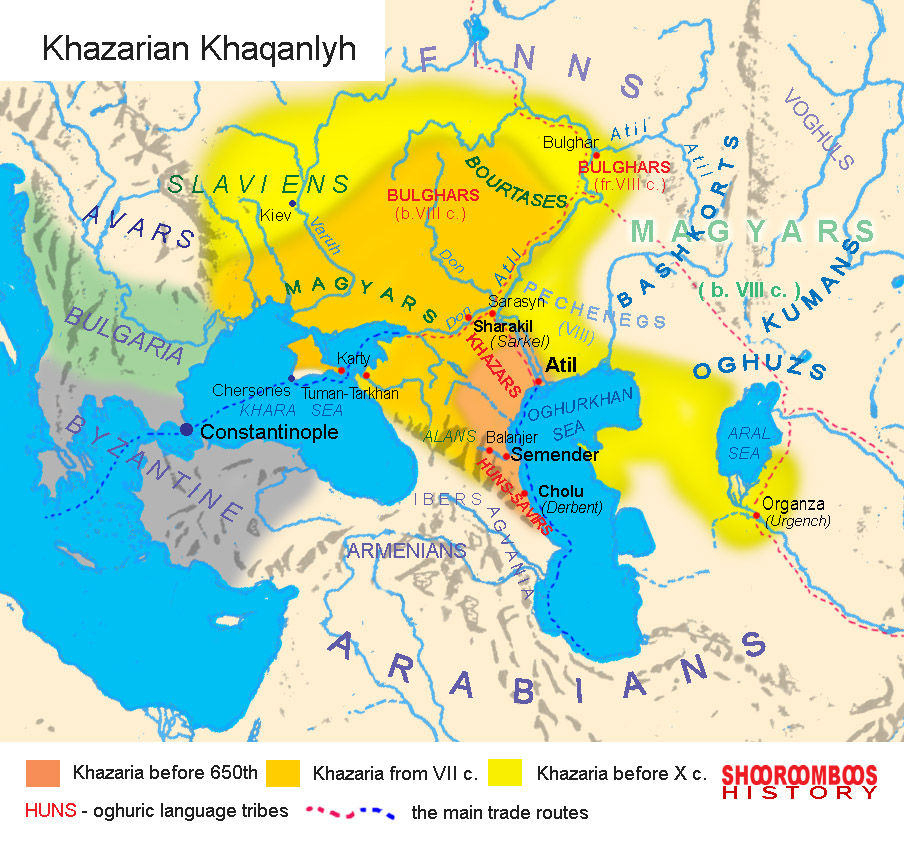
Chazarian Qaganate
The Game of Thrones among the Great Dynasties of Middle-Earth, the Great Steppe, is continued. Grand magnates from Great clans: Wu Hu, Huen, Asen, Askil, Dulo and etc - were looking for their followers.
Often the descendants of some Ases fought with the followers of other Ases, the Dulo did not get along with the Wukils. 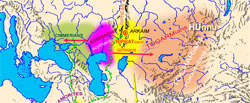
The rulers of Khazaria from the Asen clan greatly revered the Pentateuch of the Torah by the Prophet Moses. The Asens considered themselves the heirs of the biblical Thogarmah, the great-grandson of Noah. The Khazars called themselves descendants of the ten sons of Togarma (Tugarin). 

In Slavic epic legends (a bylina) tell about heroes - bogatyr'. One of these heroes was the dragon Tugarin Zmeevich - snake or serpent the Tugar (Thogarmah). His prototype was the Chuvash batyr (hero) dragon-ajdaha Tăqar Çĕlen (a serpent), or Tou-Juhha - the Mountain Super-dragon. Batyr and bogatyr - Chuvashian words too. These epic sagas for the Eastern Slavs were composed by Berendei Boyan (Bayan). Boyan - Poyan the gentility name of Chuvash. The Berendei are an ancient Chuvash tribe in Kievan Rus. Ber-Endi - fellow countryman, from one country, by Chuvash. The storyteller Bayan accompanied himself on the kesle and told these bylina. Bylina - from a chuv. pulnă that meaning events that have already happened. Chuvashian musical tool a Kesle - means the plank, thin board as veneer.

Chuvash peasants, armed with sickles, go to harvest 
In Bulgaria, near the Bolga (Volga) River, Askils became related to Dulo. Great houses fell into the shadows, giving way to others. The steppe of Middle-Earth has ceased to be Great - Aslă Uy (Ch. Аслă Уй)
The Turks are very different, they spread over vast territories. The peoples they conquered switched to Turkic dialects: Central Asia, Byzantium, Caucasus, Volga region and Siberia. And only the true core of the Xiongnu from the Scythians remained faithful to their ancestors, these were the Savir-Askils - the Chuvash; are Xyngny, from Chuv. "xyn" - a human. 
Tree of the Grand Jurts (houses) of the Great Steppes
The symbols of the house of Hu and Wukil can be considered: a dragon, a winged unicorn, a bull.
Symbols of the Askil house: all totems of all Great Houses, the Asamat rainbow and the Tree of Life. The four-sided solar sign "the Sun" was considered the most important; it is infamously known as the "swastika" (fylfot of nazi), it was greatly discredited by European savages who tried on Asian symbols for themselves. 
Symbols of the house Hun En, Wu Hu 
Symbolism of the house Asen, Ashina 
Totemistics of the Dulo house 
As Kil - Jurt (house) of As
The Ases preferred blue and gold colors. blue is the color of the sky, gold is the steppe. The Chuvash word “kil” means a home, family; quite often mentioned among ancient nomads: Rugil (Ăruqil) uncle of Attila - means the native home; Askil, Esegil, Iskil, Szekel, Wukil, Khazar's fortress-city Sarkel (Shurkil) - the white house 
The Great Steppe - the real and veritable Middle-Earth ! 
Mother Wolf - Madonna of Altai (paint. by Shooroomboos)

The Chuvash (Xynny) history by Shooroomboos >> About the same thing is described there, only in reverse presentation from ancient days to more ancient ones. However, there is a lot there that is not told here. In Bashkortstan in the Southern Urals there is a mountain - shihan Tora-tau, by Chuvash a Tora Tou - the Mountain of God. Shikhan - a single mountain. Near the shihan there is lake Tugar-Salgan; according to legend, a serpent-dragon lives in the mountain and lake, Chuvash: Tăqar Çĕlen - Serpent Tugar. The mountain and lake are of great cultural and historical significance, they are directly connected with the houses of As and Asen. The Tora-Tau shihan has rich deposits of organic material; it is constantly under the threat of being demolished by the "Soda" plant in Sterlitamak city. If the mountain is destroyed, lake Tugar-Selen (Tugar-Serpent) will also disappear. Humanity will lose unique objects of nature and ancient history. One of the shikhans of Shakh-tau (Mount of King) has already been razed to the ground, we have lost it !!! 
shihan Tora-tau and lake Tugar-salgan Perhaps Asen-Shad, the hunnic prince of the Scythians and Akazirs, passed here, fleeing from the formidable Attila the Dulo, heading East to Altai to be create a huge world of the Turks of the Turan. 
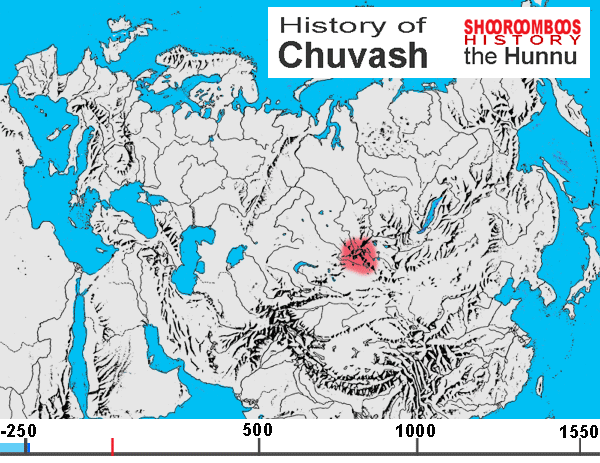
<< to main articles 
copyright © Alexander Zaryanin, 2022 |
 |
|||||||||||||||||||||||||||||||||||||||||





